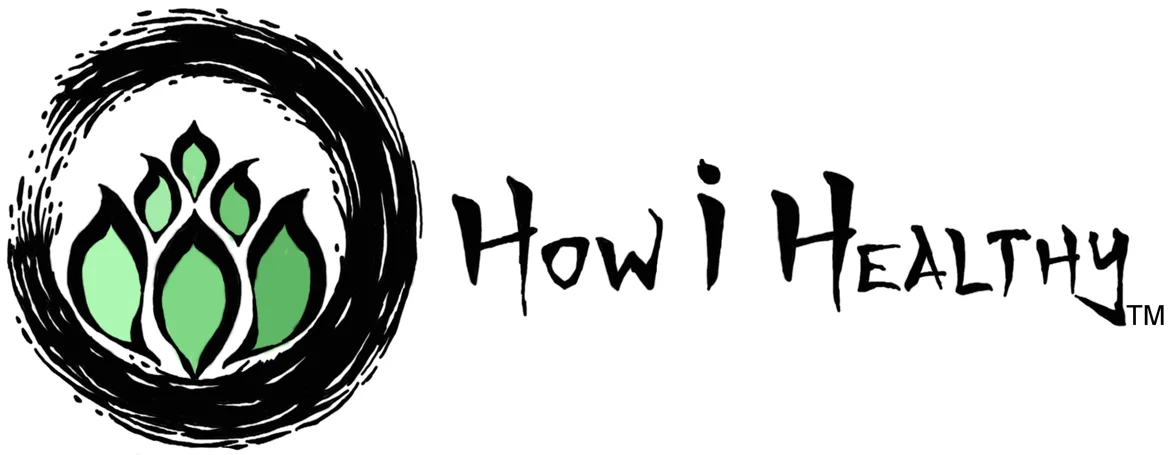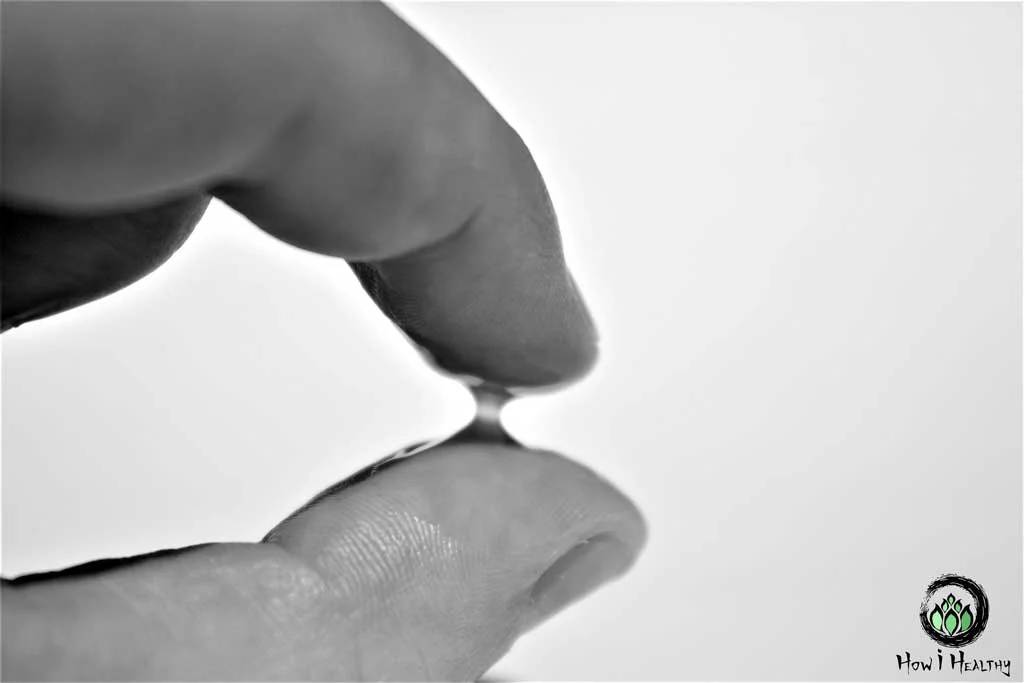In This Article, We'll Cover:
- The History of Lube
- Today’s Lube & Why it Aren’t Great
- Greenwashing in the Lube Industry
- Why Silicone Lube Hurts the Environment
- How i Healthy’s Favorite Natural Lubes & Why
Oh, lube! Glorious lube! Paired with my Favorite Sustainable Sex Toy, lube make things so smooth!
Unless its chemical-laden lube, then that good clean fun isn’t so clean.
These days lube has more flavors, more sensations, and more options than a candy shop.
Just because we can buy warming strawberry lube doesn’t mean we should.
Why Not?
Conventional lubes can contain harmful ingredients. Pair that with the vascular, absorbent, and permeable tissues of the sexual organs, mouth, and anus? We have a recipe for disaster. (1, 2, 3, 4, 13, 14, 15)
But first, let’s talk lube 101.
Lube: A Slippery History
If you’ve read other How i Healthy Guides then you know we like introducing topics with obscure history tidbits and origin stories. I’m looking at you, Bread Dildos.
I’m sorry to report lube’s history has mostly slipped away.
I unearthed only a few creditable sources that even mention it.
Most academic sources about lube refer to machinery or work processes. Not sex.
We can only make a hypothesis that lubes used in work situations were also potentially used during sex.
I digress.
The earliest types of lubes for machinery and work were often plant-based and varied around the world. (86)
Olive oil, tallow, lard, whale fat, and castor seed were used in to lubricate machinery and wheels around the world. As early as 1400 BCE, Egyptian grease made from fat and calcium lubricated chariot wheels. (86)
In 1872, petroleum jelly hit the consumer market. Although not intended as a personal lubricant, it is speculated to have been used for sex. But there is no official data to back up the hypothesis. (84)
The next lube evolution hit when English chemist, Frederic Kipping, discovered polymer silicone around 1900. Again, this slick substance was not intended to be used as a sexual lubricant, perhaps it was nonetheless. (85)
In 1919, medicinal lubricants, like menthol-infused lube, offered topical pain relief. Folks learned quickly that cooling/heating lubes had other useful purposes too. Capitalizing on this market, medical lubes shifted gears to the consumer sector. (42)
A 1989 account referenced vegetable shorting as an edible lube not compatible with latex condoms (41). Vegetable shorting had been around in the earl 1900s (87). We can hypothesize that it was probably used as a lube well before the article about latex condoms was published.
But other than that, there’s not much else. So, I’ll jump right to science.
Problems with Lube
I like lube. But like with most things, I’m skeptical about what’s in it.
Turns out, that skepticism is well founded.
Bad for Our Bodies: Ingredients
Reading a label of a conventional lubricant you might find things like:
- Benzocaine
- “Fragrance” & “Flavors” & Phthalates
- Glycerin/Glycerol
- Parabens
- Petrochemicals like Propylene Glycol
- 1,3-Proanediol
- Nonoxynol-9, Microbicides, Spermicidals
- Sugars, glucose, honey (In vaginas? No, thank you.)
(13, 14, 15, 43, 55, 63)
I explore these chemicals and offer ways to avoid them in The Chemicals Guide.
Even if a lube doesn’t have these ingredients, there’s another other things to keep in mind.
Bad for Our Bodies: Osmolality
If a vagina and/or anus are a part of your sex life, then pH, osmolality, and how lube can disrupt them are important considerations.
First, osmolality.
Think about osmosis, derived from the Greek word “push, thrust”. A high concentration of particles (water in this case) pushes through cell walls and tissue to lower water concentration zones. This is called osmotic pressure. This movement/dilution balances the two out. (58, 59)
In the vagina and anus, water moves back and forth, maintaining balance. This keeps them happy and moist.
Some lubes disrupt this natural osmosis. Hyperosmolal, or high-osmolality, lube, for instance.
High-osmolality, lube will pull water from tissue. This dehydrates the cells, leading to tissue damage, death, and increased susceptibility to bacterial infection and STIs. (55, 57, 60)
Another way of looking at it: A sponge.
A wet sponge absorbs less water than a dry sponge because a wet sponge is more similar to the water environment.
Some lubes are like dry sponges.
They suck the moisture out of the vagina and anus, drying them out.
(55, 57, 60)
But Hyporosmolal, or low-osmolality, lube hydrates cells and tissues. Unless it was extremely hypo-osmotic. This would flood water to the cells. Bursting them and causing cellular damage.
So, we want lube that is similar to the vaginal or anal environment, like a wet (not sopping or dry) sponge. Or to be accurate, an iso-osmolality lube:
- Vaginal lube osmolality of >400 mOsm/kg. Vaginal fluid is 370 ±40 mOsm/kg. (57)
- Colon lube osmolality of approximately ∼290 mOsm/kg, the same as colon osmolality (60)
But many lubes aren’t.
86% of lubes tested were high-osmolality. (55, 57)
If a lube doesn’t list their osmolality look for ingredients that are hyperosmolal:
- Glycerin
- Glycerol
- PEG compounds
- 1,2-Propanediol (AKA Propylene Glycol)
- 1,3-Propanediol
(57, 60, 64, 68)
Ingredients like this indicate a lube is likely high-osmolality.
Greenwashing Alert: 1,3-Propanediol
1,3-Propanediol is often toted as an “all natural” alternative to petrochemical derived propylene glycol. It is derived from corn sugar or palm oil after all. (83)
And 1,3-Propanediol can even be certified organic! (83)
But 1,3-Propanediol behaves very similarly to propylene glycol.
That means high osmolality. Lube with 1,3-Propanediol tested over 2000 mOsm/kg in one study. 1,3-Proanediol reached similar levels as lubes made with propylene glycol, glycerin, and PEG. (79)
Don’t be fooled by the “derived from plants!” or “certified organic 1,3-Propanediol” on some lubes.
Just because something is made from plants, doesn’t mean it’s all that great. Just look a Greenwashed Bioplastic.
Bad for Our Bodies: pH
Let’s add one more layer to this. pH.
- Vaginal: pH 3.8-4.5
- Menopausal Vaginal: pH 6.0-7.5
- Rectal: pH7
(55, 6)
But many lubes on the market don’t keep these pH ranges or osmolality in mind.
This can cause yeast infections, bacterial vaginosis, and make the body more susceptible to STIs. (15, 56, 57, 61, 62, 64)
But wait! There’s more! Lube also affects the planet.
Bad for Our Earth: Silicone
Some lubes impact the Earth too. I’m talking about silicone. Not to be confused with silicon. The “E” is important.
Silicon is the naturally occurring element, silica, heated up. Silicone is a synthetic polymer that requires petroleum or natural gas to form. (46, 47)
Here’s how silicone is made:
- First, there’s Silica, or more accurately, silicon dioxide (SiO2) because it’s linked by oxygen (O). It’s the most abundance substance on Earth. It’s found in beach sand, quartz, and most rocks.
- Silicon dioxide is heated with carbon (typically charcoal). This creates silicon. Silicon is a semiconductor, perfect for electronics, circuits, and microchips. Silicon and computer tech? Ring a bell? Silicon Valley, in San Francisco .
- Silicon then reacts with fossil fuel-derived hydrocarbons, typically petroleum or natural gas. This creates Silicone, a flexible, heat-resistant, and plastic-like material used in many applications.
(46, 47)
Silicone has many versatile characteristics. Similar to plastic. For this article, we’ll focus on oil-like silicones. I cover plastic-like silicones and silicone bakeware in The Chemicals Guide.
Silicone is complicated when it comes to eco-friendliness. There’s pros and cons. The big ones being:
- Although not petroleum-derived like some plastics, silicone production still requires some oil or natural gas. But less than plastic does. (46, 47)
- Silicone oil has been found in natural water sources (even in Antarctica!) and can suffocate and harm small organisms. (45, 50, 51, 52, 53)
There’s many names for silicone. Here’s a few found in silicone-based lubes:
- Dimethicone / Polydimethylsiloxane
- A suspected “persistent and environmental toxin” according to the Canada Domestic Substance List. (44)
- Dimethiconol
- There is a lack of data on the safety on dimethiconol. But an expert panel concluded it does not absorb into the skin. This minimizes the risks it might pose. But dimethiconol is dangerous to aquatic life, according to the European Chemicals Agency (ECHA). (53, 54)
- Cyclomethicone
- A bioaccumulative hormone disruptor, endocrine disruptor, and reproductive toxin for both humans and wildlife. (45)
Several publications state that humans do not absorb silicones easily, and thus do not absorb their potential toxins (54). But that’s not the case for aquatic life or the environment.
I’d rather pick more sustainable options.
So, if silicone, harsh pH, chemicals, and other junk are off the table, what’s left?
My Favorite Natural Lubes
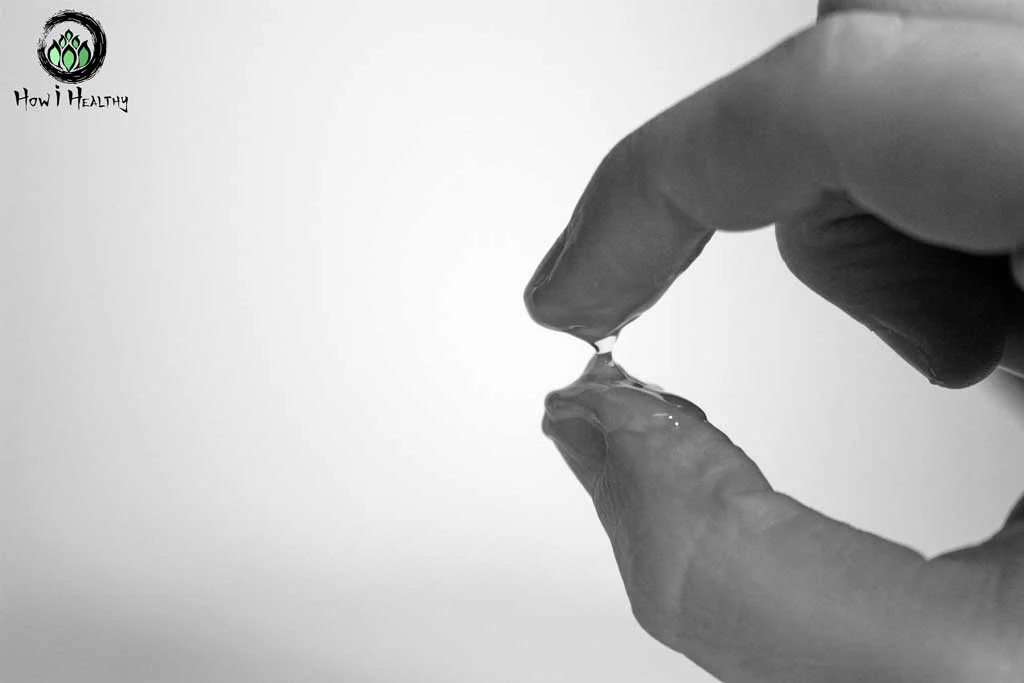
Are we doomed to a life without lube?
Fear not!
There are a few natural lube brands out there that make the How i Healthy cut.
But first, what criteria guided my chooses?
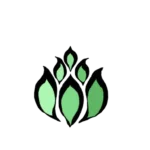
The How i Healthy Standard
Our favorite products/brands meet as many of these conditions as possible.
Healthy body, healthy planet, & healthy sex means:
- Align with My Best Sustainability & Ethical Tips
- As Local as Possible
- Cruelty-Free
- Doesn’t Contain these Harmful Chemicals
- Environmental and/or Socially Responsible Company
- Ethically Made: Fair Trade, Living Wages, Safe Worker Conditions
- Gender-inclusive
- No Greenwashing Scams
- Organic & Sustainably Harvested Ingredients
- Pass How i Healthy’s Counterfeit Vetting Process
- Purchased Through/From an Ethical Shop/Marketplace.
- Zero Waste / Plastic & Bioplastic-free / Home Compostable
- 1% for the Planet®, B Corporation®, Green American Business®, or similar credentials
With all that in mind, I’ve found a few different options. The natural lubes I like fall into these categories:
- Aloe vera-based
- Oil-based
- Water-based
It’s a personal choice which lube you use. And your choice can vary on many factors like:
- Any allergies or sensitivities you and/or partner(s) might have
- Method and material of barrier (if using)
- Sex toy material (silicone, glass, metal, ceramic)
- Where the fun is taking place (e.g., the shower)
- Where you prefer to shop (e.g., lubes made in your home country or not.)
- Vaginal penetration vs. anal vs. oral vs. masturbation
- You and/or your partner(s) preference
Having a few options nearby can prepare us for whatever and wherever sexy times might happen.
Here’s some of my favorite sustainable & ethical natural lube options. Listed in alphabetical order.
Bonk Lube
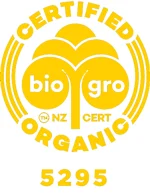
Product Kudos
Origin: New Zealand.
End of Life: Plastic tube, plastic-free packaging.
Ingredients/Packaging:
- BonkTM Water-Based Lube: Water, Aloe Vera, Guar Gum, Microcare, Harakeke Extract, Citric Acid. (88)
- BonkTM Oil-Based Lube: Sunflower Seed Oil, Shea Butter, Jojoba Oil, Beeswax, Cocoa Seed Butter. (88)
Why It’s Awesome:
- A great local option for folks in and near New Zealand.
Certified organic, that means no GMOs, pesticides, or herbicides.
Cruelty free.
Made in New Zealand! And with native New Zealand plants, like harakeke.
pH Range: 3.8-4.5, optimal for vaginal use.
- No chemical junk. No glycerin, glycol, parabens, fragrance, PEG, propylene glycol, 1,3-Propanediol , or sulfates.
- Water and oil-based lube give options for both in and out of shower/tub/river/ocean (anywhere wet!).
(88)
Company Kudos
- Donates a portion of its proceeds to OCRA (Ovarian Cancer Research Alliance) to help in the fight against cancer.
- Gender-inclusive & non-judgmental shopping experience.
- Woman-owned businesses.
Coconu
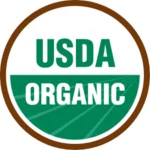
Product Kudos
Origin: Utah, USA.
End of Life: Plant-based (sugarcane ethanol) bioplastic.
Ingredients/Packaging:
- Coconu Coconut Water-Based Lube: Coconut Water*, Xanthan Gum, Gaur Gum, Potassium Sorbate, Sodium Benzoate. (89)
- Coconu Oil-Based Lube: Sunflower Seed Oil*, Coconut Oil*, Cera Alba (Beeswax)*, Butyrospermum Parkii (Shea Butter)*, Theobroma Cacao (Cocoa) Seed Butter*, Prunus Amygdalus Dulcis (Sweet Almond) Oil*, Aleurites Moluccana (Kukui) Seed Oil*, Hippophae Rhamnoides (Sea Buckthorn) Oil*, Tocopherol (Non-GMO)* (90)
(* indicates organic)
Why It’s Awesome:
- No chemical junk. No parabens, fragrance, petrochemicals, PEG, propylene glycol, 1,3-Propanediol, glycerin, natural flavors, or glycerol.
- pH balanced for vaginas.
- Water and oil-based lube give options for both in and out of shower/tub/river/ocean (anywhere wet!).
(89, 90)
Company Kudos
- Donates a portion of its proceeds to OCRA (Ovarian Cancer Research Alliance) to help in the fight against cancer.
- Gender-inclusive & non-judgmental shopping experience.
Good Clean Love®
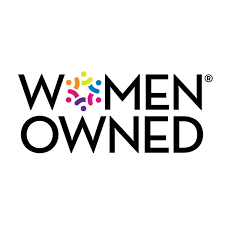
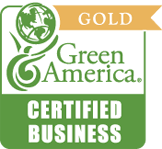
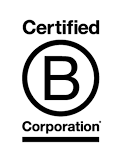
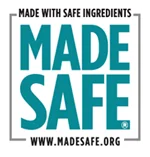




Product Kudos
Origin: USA.
End of Life: Recyclable Plant-based (sugarcane ethanol). Toss cap in trash, cut the tube in half, rinse out & let it dry before Recyling.
Ingredients/Packaging: Sugarcane tube with plastic cap top.
Base ingredients: Purified Water, Hydroxyethyl cellulose, Xanthan Gum, Carrageenan, Sodium Chloride, Lactic Acid, Potassium Sorbate, Sodium Benzoate, Ceratonia Siliqua Gum, Potassium Chloride, Calcium Chloride. (29)
- BioNude™ Ultra Sensitive: Base ingredients. This lube is also Made Safe™ (29, 37)
- BioGenesis™ Fertility: Base ingredients but no gums, carrageenan, or thickeners. Instead, there’s Magnesium Chloride and Potassium Sorbate, both of which support sperm movement and egg penetration. (30)
- This lube is a water-based, hydroxyethyl cellulose formula, recommended by the Mayo Clinic as the optimal kind of lube to use while trying to conceive. (30)
- This is the closest thing to natural vaginal moisture a lube can get. That means, unlike many lubes out there, this lube less likely to hinder sperm motility. If you’re trying to get pregnant, this research-based, patent-pending formula might be worth talking to your doctor about. (30, 31, 32)
- Note: Good Clean Love® makes a few other lubes, but one has Natural Flavors and the other has Propanediol. So BioNude™ & BioGenesis™ are the only two I like from Good Clean Love® .
Why It’s Awesome:
- It’s great for non-shower sex, most sex toys, and masturbation (self & partner(s)).
- pH Range: 3.8-4.2, optimal for vaginal use.
- Actually states its Osmolality Range. Which is: 250-400 mOsmol/kg. Optimal for vaginas.
- No chemical junk. No parabens, fragrance, petrochemicals, PEG, propylene glycol, 1,3-Propanediol, glycerin, natural flavors, or glycerol. (33)
Company Kudos
- Actively working on becoming a 1% for the Planet® member.
- Certified B-Corp® and Green American Business®. (34, 35)
- 100% plant-based (sugarcane ethanol) bioplastic. Bioplastic has plenty of problems and isn’t as green as folks think, but hey, at least it’s not petroleum-based. According to their website, there tubes can be recycled in conventional recycling. (35, 75, 76, 77, 78)
- Woman-owned business. Founder and CEO, Wendy Strgar, is also a sexual health educator. (36)
- Won the PETA Compassionate Company Award for advocacy against FDA animal testing requirements for personal lubricants. (34)
Intamo
Product Kudos
Origin: Victoria B.C., Canada.
End of Life: Recyclable amber glass bottle.
Ingredients/Packaging:
- Smooth Operator Water-Based Lube: Aloe Vera, Hyaluronic Acid, Rose Water, Potassium Sorbate, Sodium Benzoate, Citric Acid, Gar Gum. (71)
- Wild Thing Oil-Based Lube: Sesame Oil, MCT Fractionated Coconut Oil, Vit. E Oil, Organic Hemp-Seed Oil. (72)
Why It’s Awesome:
- As the name suggests, water-based Smooth Operator is indeed very smooth. It’s slippery, not sticky, and lasts. It’s great for non-shower sex, most sex toys, and masturbation (self & partner(s)).
- Glass packaging.
- Made in Canada!
- No chemical junk. No parabens, fragrance, petrochemicals, PEG, propylene glycol, 1,3-Propanediol, glycerin, natural flavors, or glycerol.
- Wild Thing is oil-based, it’s great in and out of the shower, for long lasting sessions, and all non-silicone sex toys.
(73)
Company Kudos
- Acknowledges the land rights of the Songhees and Esquimalt Peoples.
- Acknowledges their own white privilege and desire to improve their allyship against racism, colonial violence, gender-based inequality and violence, violence against sex workers, transphobia, ableism, and homophobia.
- All products are made in Victoria B.C. Canada.
- Gender-inclusive & non-judgmental shopping experience.
- Percentage of every sale goes to providing free local (Vancouver Island & Vancouver) sex education.
(70, 71, 74)
Lucy Lube
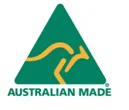
Product Kudos
Origin: New South Wales, Australia.
End of Life: Recyclable glass bottle and recyclable plastic pump.
Ingredients/Packaging:
- Water-Based Lucy Lube: Water, Cyamopsis Tetragonoloba (Guar) Gum, Xanthan Gum, Sodium Benzoate, Potassium Sorbate, Ale Barbadensis Leaf Juice Powder, Citric Acid. (81)
Why It’s Awesome:
- A great local option for folks in and near Australia.
- Best for non-shower sex, most sex toys, and masturbation (self & partner(s)).
- Bottled in glass with no unnecessary packaging.
- Gender-inclusive & non-judgmental shopping experience.
- Made in Australia! Even their labels and packaging.
- Offers carbon offset shipping options.
- pH Range: 4.3, optimal for vaginal use.
- No chemical junk. No glycerin, glycol, parabens, fragrance, PEG, propylene glycol, 1,3-Propanediol , or sulfates.
(80, 81)
Sliquid® Organics: Aloe Vera-Based Lubes
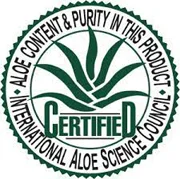
Product Kudos
Origin: USA.
End of Life: Recyclable plastic bottle.
Ingredients/Packaging:
Base Ingredients: Organic Aloe Barbadensis Decolorized Leaf Juice*, Organic Agar Agar, Organic Guar Gum, Natural Tocopherols (Vitamin E), Organic Hibiscus Extract, Organic Flax Extract, Organic Green Tea Extract, Organic Sunflower Seed Extract, Potassium Sorbate, Citric Acid. (21)
The Sliquid® Organics line use aloe vera as the main base instead of water or oil.
The four aloe vera lubes below have similar ingredients. It’s really down to personal preference on consistency and if you want additional features in your lube.
- Sliquid® Organics Natural: Base ingredients. (21)
- Sliquid® Organics Natural Gel: Base ingredients but twice the agar agar. This creates a thicker consistency ideal for anal play. 20)
- Sliquid® Organics Sensation: Base ingredients plus organic peppermint oil and organic menthol. This combo can heighten sensitivity by starting cool then warming up with friction. (22)
- Sliquid® Organics Oceanics: Basic ingredients plus carrageenan and organic Nori seaweed. Nori is a red algae packed with B vitamins, zinc, iodine, iron, and copper that might help support vaginal moisture and lubrication. (23)
Why It’s Awesome:
- All the options! Thinner & thicker consistencies, natural cooling sensations. Who knew aloe could be so versatile?
- All of these lubes actually contain aloe vera. It has the International Aloe Science Council (IASC) certification to back it up.
- Best for non-shower sex, most sex toys, and masturbation (self & partner(s)).
- Compatible with most toys and materials.
- No chemical junk. No parabens, fragrance, petrochemicals, PEG, propylene glycol, 1,3-Propanediol, glycerin, natural flavors, or glycerol.
- pH Range: 4.0-4.4, optimal for vaginal use.
- Water-soluble and easy to clean up.
(18, 19, 21, 22, 23, 24)
Company Kudos
- Donates yearly to social justice & LGBTQA nonprofits, sexual education and resource providers, animal rescues, and medical research foundations. (4)
- Listed on the NAASAS Safe Sexual Products Campaign Business Directory. (34)
- Gender-inclusive language and shopping experience.
Sliquid® Naturals: Water-Based Lubes
Product Kudos
Origin: USA.
End of Life: Recyclable plastic bottle.
Ingredients/Packaging:
Base Ingredients: Purifired Water, Plant Cellulose (From Cotton), Cyamopsis (Guar Conditioners), Potassium Sorbate, Citric Acid. (25)
Similar to the aloe vera-based line, the water-based has similar ingredients with slight variations. It’s really down to personal preference on consistency and if you want additional features in your lube.
- Sliquid® H20: Base ingredients. (25)
- Sliquid® Sassy: Base ingredients but twice the cellulose. This creates a thicker consistency ideal for anal play. 4 (26)
- Sliquid® Sizzle: Base ingredients with food grade Menthol. This adds a warming and cooling sensation. (27)
- Sliquid® Sea: Base ingredients with seaweed extracts Carrageenan, Nori, and Wakame. These extracts might promote vaginal hydration and natural lubrication. (28)
Why It’s Awesome:
- Best for non-shower sex, most sex toys, and masturbation (self & partner(s)).
- Compatible with most toys and materials.
- Like the Organics line, these offer different consistencies and other elements that give you lots of options.
- No chemical junk. No parabens, fragrance, petrochemicals, PEG, propylene glycol, 1,3-Propanediol, glycerin, natural flavors, or glycerol. (24)
- pH Range: 4.0-4.4 is optimal for vaginal use.
Other Concerns
Lube is only the beginning.
Condoms
Condoms can contain many of the same chemicals as lube.
Things like Benzocaine, Nonoxynol-9, N-Nitrosamine, glycerin, parabens, and phthalates (10, 11, 12).
So, if condoms are a part of your sex life, check out this Guide to Eco-Friendly Condoms to learn some random condom history facts and see my favorite (biodegradable & certified Ethical!) brand.
Sex Toys
Why go through all the trouble in picking a sustainable & ethical lube then leave sex toys out of the conversation?
Sex toys in the US are largely unregulated and can contain phthalates. Phthalates can leach from cheap plastics and PVC into the skin. (7)
The US has made motions to ban certain forms of phthalates in children’s toys. (9)
What about adult toys? No Such luck. We are on our own.
This Sex Toy Materials Guide can help navigate through the mess of toxic toys.
And this Ethical Sex Shop & Manufacture Guide can help make sure your sex toy purchase doesn’t harm the environment or perpetuate forced labor.
Sex Toy Greenwashing
Speaking of the environment.
I loathe greenwashing, or marketing a product as “eco-friendly” when it’s not.
And sex toy greenwashing is no different.
Companies know that “green sex sells”. 66% of consumers are willing to pay big money for sustainable and socially responsible products. (82)
And companies exploit our good intentions by marketing products with catchy green labeling & misdirection.
And consumers buy in. At premium prices.
If the words “compostable” & “recyclable” bioplastic vibrators sound eco-friendly to you, read The Sex Toy Greenwashing Guide. Your wallet, the Earth, and forced laborers will thank you.
The Takeaway Message
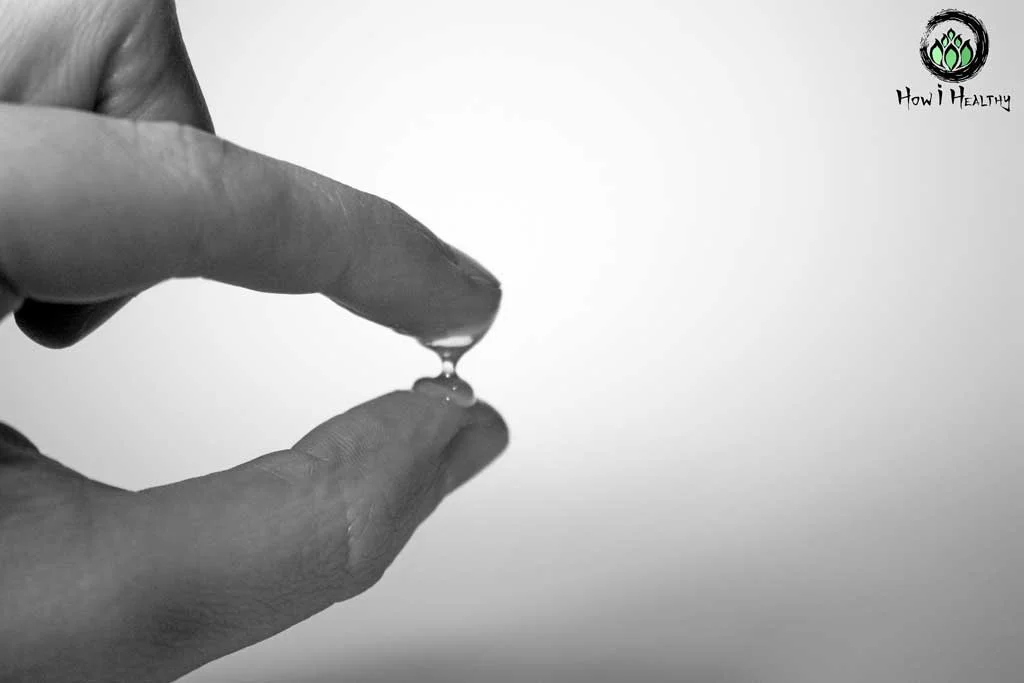
Some lubes can harm our body. And when put lube the most vascular, absorbent, and permeable places of our bodies, it compounds the issue. (1, 2, 3, 4, 13, 14, 15, 56, 57, 61, 62, 64)
Silicone is a bio-accumulative hormone disruptor and endocrine disruptor for both humans and wildlife. (45, 50, 51, 52, 53, 54)
No fear! There are natural lubes designed with our bodies and the Earth in mind. Plus, they come from cool family-run companies!
Want certified organic? B-Corp? USA, Canada, or Australian made? Biodegradable packaging? Gender-inclusive shopping?
Honey, you got options!
Made in America
- Certified USDA organic.
- Donates a portion of its proceeds to OCRA (Ovarian Cancer Research Alliance) to help in the fight against cancer.
- Gender-inclusive language and shopping experience.
- Good for:
- Folk allergic to or not wanting aloe-based lubes.
- Folks wanting to support a business that gives back to people & planet.
- Folks who might feel overwhelmed by too many lube options.
- Environmental stewardship, Green American Business, and B-Corp awesomeness.
- Woman-owned business.
- 100% plant-based bioplastic packaging that’s actually recyclable.
- Good for:
- Folks trying to conceive. (See: BioGenesis™ Fertility)
- Folks who might feel overwhelmed by too many lube options.
- Folks wanting to support a business that gives back to people & planet.
- Water-based lube.
- Donates yearly to nonprofits, animal shelters, sexual education, and medical research.
- Gender-inclusive language and shopping experience.
- Good for:
- Aloe vera-based & water-based lube.
- Folks wanting to support a business that gives back to people & planet.
- Folks who want more lube options.
- Options like: thinner or thicker consistencies, cooling sensations, or seaweed extracts.
Made in Australia & New Zealand
- Certified organic.
- Gender-inclusive language and shopping experience.
- Woman-owned business.
- Good for:
- Water/Aloe vera-based & oil-based lube
- Folks who might feel overwhelmed by too many lube options.
- Acknowledges the land rights of the Wurundjeri/Woiwurrung people of the Kulin Nation.
- Glass packaging, Australian-made labels and compostable packaging.
- Certified Australian Made®
- Gender-inclusive language and shopping experience.
- Good for:
- Water-based lube.
- Folks who might feel overwhelmed by too many lube options.
- Folks who want less plastic packaging.
Made in Canada
- Acknowledges the land rights of the Songhees and Esquimalt Peoples.
- Every purchase helps fund free sex education in the Vancouver area.
- Gender-inclusive language and shopping experience.
- Glass bottle with paper packaging sourced from local vendors in Québec.
- Good for:
- Aloe vera-based & oil-based lube.
- Folks who might feel overwhelmed by too many lube options.
- Folks wanting to support a business that gives back to people & planet.
- Folks who want less plastic packaging.
That’s How i Healthy!
-Artemis
- Buttar, H S. “Transvaginal Absorption and Disposition of Nonoxynol-9 in Gravid Rats.” Toxicology Letters, U.S. National Library of Medicine, Oct. 1982, ncbi.nlm.nih.gov/pubmed/6293122
- Tourgeman, David E., et al. “Serum and Tissue Hormone Levels of Vaginally and Orally Administered Estradiol.” American Journal of Obstetrics and Gynecology, vol. 180, no. 6, 1999, pp. 1480–1483., doi:10.1016/s0002-9378(99)70042-6. https://pubmed.ncbi.nlm.nih.gov/10368494/
- Needham, Shawn, and Shane Needham. “Case Study: Absorption of Testosterone Cream via Scrotal Delivery.” International Journal of Pharmaceutical Compounding, U.S. National Library of Medicine, 2018, ncbi.nlm.nih.gov/pubmed/30384346
- Gupta, P.J. “Suppositories in Anal Disorders: a Review.” https://pubmed.ncbi.nlm.nih.gov/17970232/
- “ Safe Sexual Products Business Directory.” The National Association for the Advancement of Science & Art in Sexuality: NAASAS https://naasas.org/safe-sexual-products-directory.htm
- “Product Classification.” fda.gov, www.accessdata.fda.gov/scripts/cdrh/cfdocs/cfPCD/classification.cfm?ID=HIS
- Zach Biesanz, Dildos, Artificial Vaginas, and Phthalates: How Toxic Sex Toys Illustrate a Broader Problem for Consumer Protection, 25 Law & Ineq. 203. 2007, https://scholarship.law.umn.edu/lawineq/vol25/iss1/5/
- “Phthalates Action Plan.” S. Environmental Protection Agency , 2012, www.epa.gov/sites/production/files/2015-09/documents/phthalates_actionplan_revised_2012-03-14.pdf
- “CPSC Prohibits Certain Phthalates in Children’s Toys and Child Care Products.” S. Consumer Product Safety Commission, 8 Nov. 2017, www.cpsc.gov/Newsroom/News-Releases/2018/CPSC-Prohibits-Certain-Phthalates-in-Childrens-Toys-and-Child-Care-Products
- Motsoane, N A et al. “An in vitro study of biological safety of condoms and their additives.” Human & experimental toxicology 22,12 (2003): 659-64. doi:10.1191/0960327103ht410oa. https://journals.sagepub.com/doi/10.1191/0960327103ht410oa
- Motsoane, N A et al. “The biological safety of condom material can be determined using an in vitro cell culture system.” Analytical cellular pathology : the journal of the European Society for Analytical Cellular Pathology 23,2 (2001): 51-9. doi:10.1155/2001/172657. https://pubmed.ncbi.nlm.nih.gov/11904460/
- “Making a Good Thing Even Better: Removing NITROSAMINES from CONDOMS.” Reproductive Health Technologies Project, 2014, https://fc2.us.com/wp-content/uploads/2016/10/MakingAGoodThingEvenBetter.pdf
- Cunha, Ana Raquel, et al. “Characterization of Commercially Available Vaginal Lubricants: a Safety Perspective.” Pharmaceutics, MDPI, 22 Sept. 2014, ncbi.nlm.nih.gov/pmc/articles/PMC4190534/
- Nicole, Wendee. “A Question for Women’s Health: Chemicals in Feminine Hygiene Products and Personal Lubricants.” Environmental Health Perspectives, National Institute of Environmental Health Sciences, Mar. 2014, ncbi.nlm.nih.gov/pmc/articles/PMC3948026/
- Dezzutti, Charlene S, et al. “Is Wetter Better? An Evaluation of over-the-Counter Personal Lubricants for Safety and Anti-HIV-1 Activity.” PloS One, Public Library of Science, 2012, ncbi.nlm.nih.gov/pubmed/23144863/
- Poordast, Tahereh et al. “Aloe Vera; A new treatment for atrophic vaginitis, A randomized double-blinded controlled trial.” Journal of ethnopharmacology 270 (2021): 113760. doi:10.1016/j.jep.2020.113760. https://pubmed.ncbi.nlm.nih.gov/33383112/
- “IASC Certification Program .” International Aloe Science Council > Certification > Program Details, iasc.org/Certification/ProgramDetails.aspx
- Mulvany, Lydia, and Zek Faux. “No Evidence of Aloe Vera Found in the Aloe Vera at Wal-Mart, CVS.” com, Bloomberg, 22 Oct. 2016, www.bloomberg.com/news/articles/2016-11-22/no-evidence-of-aloe-vera-found-in-the-aloe-vera-at-wal-mart-cvs.
- “Aloe Vera – False Advertising & No Aloe Suit.” com, www.classaction.com/aloe-vera/
- “Natural Gel – Our Thick, Clean, & Simple Aloe Blend – Sliquid Organics.” Sliquid Natural Intimate Products, sliquid.com/shop/sliquid-organics/organics-aloe-based/natural-gel-sliquid-organics/.
- “Organics Natural – A Clean & Simple Aloe Based Blend – Sliquid Organics.” Sliquid Natural Intimate Products,sliquid.com/shop/sliquid-organics/organics-aloe-based/natural-sliquid-organics/.
- “Sensation – Our Stimulating Aloe Based Lubricant – Sliquid Organics.” Sliquid Natural Intimate Products, sliquid.com/shop/sliquid-organics/organics-aloe-based/sensation-sliquid-organics/.
- “Oceanics – Our Natural Lubricant with Seaweed Extracts – Sliquid Organics.” Sliquid Natural Intimate Products, sliquid.com/shop/sliquid-organics/organics-aloe-based/oceanics-sliquid-organics/.
- “All About Sliquid – Natural Intimate Lubricants and Products for Women.” Sliquid Natural Intimate Products, 23 Nov. 2020, sliquid.com/about-sliquid/.
- “H2O – Our Clean and Simple Water-Based Blend – Sliquid Naturals.” Sliquid Natural Intimate Products, sliquid.com/shop/sliquid-naturals/naturals-water-based/h2o-sliquid-naturals/.
- “Sassy – Our Clean & Simple Water-Based Blend, Only Thicker – Sliquid.” Sliquid Natural Intimate Products, sliquid.com/shop/sliquid-naturals/naturals-water-based/sassy-sliquid-naturals/.
- “Sizzle – Our Water Based Stimulating Formula – Sliquid Naturals.” Sliquid Natural Intimate Products, sliquid.com/shop/sliquid-naturals/naturals-water-based/sizzle-sliquid-naturals/.
- “Sea – Our Carrageenan Infused Water-Based Lubricant – Sliquid Naturals.” Sliquid Natural Intimate Products, sliquid.com/shop/sliquid-naturals/naturals-water-based/sea-sliquid-naturals/.
- “BioNude™ Ultra Sensitive Personal Lubricant.” Good Clean Love, goodcleanlove.com/products/bio-nude-personal-lubricant.
- “BioGenesis™ Fertility Lubricant.” Good Clean Love, goodcleanlove.com/products/biogenesis-fertility-lubricant.
- Agarwal, Ashok et al. “Effect of vaginal lubricants on sperm motility and chromatin integrity: a prospective comparative study.” Fertility and sterility 89,2 (2008): 375-9. doi:10.1016/j.fertnstert.2007.02.050/. https://pubmed.ncbi.nlm.nih.gov/17509584/
- Frishman, G N et al. “Evaluation of Astroglide, a new vaginal lubricant: effects of length of exposure and concentration on sperm motility.” Fertility and sterility 58,3 (1992): 630-2.
- “Safe Ingredients.” Good Clean Love, goodcleanlove.com/pages/ingredients.
- “Our Story.” Good Clean Love, goodcleanlove.com/pages/our-story.
- “Frequently Asked Questions.” Good Clean Love, goodcleanlove.com/pages/faq.
- “Meet Good Clean Love Founder Wendy Strgar.” Good Clean Love, goodcleanlove.com/pages/meet-ceo-wendy-strgar.
- “We’re MADE SAFE Certified.” Good Clean Love, goodcleanlove.com/pages/made-safe.
- Molazem, Zahra et al. “Aloe vera gel and cesarean wound healing; a randomized controlled clinical trial.” Global journal of health science 7,1 203-9. 31 Aug. 2014, doi:10.5539/gjhs.v7n1p203. https://pubmed.ncbi.nlm.nih.gov/25560349/
- Oryan, Ahmad et al. “Topical Application of Aloe vera Accelerated Wound Healing, Modeling, and Remodeling: An Experimental Study.” Annals of plastic surgery 77,1 (2016): 37-46. doi:10.1097/SAP.0000000000000239. https://pubmed.ncbi.nlm.nih.gov/25003428/
- Fox, Lizelle T et al. “Skin permeation enhancement effects of the gel and whole-leaf materials of Aloe vera, Aloe marlothii and Aloe ferox.” The Journal of pharmacy and pharmacology 67,1 (2015): 96-106. doi:10.1111/jphp.12311. https://academic.oup.com/jpp/article/67/1/96/6128007?login=false
- Crimp, Douglas. “Mourning and Militancy.” October, vol. 51, 1989, p. 11., doi:10.2307/778889. https://www.jstor.org/stable/778889
- “K-Y® Brand Lubricant, 1919.” History of K-Y® Brand Jellies & Lubricants | Johnson & Johnson Our Story, ourstory.jnj.com/k-y-brand-lubricant.
- “Ingredients in Lubricants – Chemicals of Concern in Feminine Care Products.” Women’s Voices for the Earth, womensvoices.org/ingredients-of-lubricants-chemicals-of-concern/
- “EWG Skin Deep®: What Is DIMETHICONE.” EWG, ewg.org/skindeep/ingredients/702011-DIMETHICONE/
- “EWG Skin Deep®: What Is CYCLOMETHICONE.” EWG, ewg.org/skindeep/ingredients/701738-CYCLOMETHICONE/
- Institute of Medicine (US) Committee on the Safety of Silicone Breast Implants; Bondurant S, Ernster V, Herdman R, editors. Safety of Silicone Breast Implants. Washington (DC): National Academies Press (US); 1999. 2, Silicone Chemistry. https://www.ncbi.nlm.nih.gov/books/NBK44788/
- Castro, Joseph. “Silicon or Silicone: What’s the Difference?” LiveScience, Purch, 20 June 2013, livescience.com/37598-silicon-or-silicone-chips-implants.html.
- “Silicone Uses.” Silicones Environmental, Health, and Safety Center, American Chemistry Council , https://www.americanchemistry.com/industry-groups/silicones-environmental-health-and-safety-center-sehsc
- Fromme, Hermann et al. “Siloxane in baking moulds, emission to indoor air and migration to food during baking with an electric oven.” Environment international 126 (2019): 145-152. doi:10.1016/j.envint.2019.01.081. https://pubmed.ncbi.nlm.nih.gov/30798195/
- Watanabe, N et al. “Distribution of silicones in water, sediment and fish in Japanese rivers.” The Science of the total environment 73,1-2 (1988): 1-9. doi:10.1016/0048-9697(88)90180-5. https://www.sciencedirect.com/science/article/abs/pii/0048969788901805?via%3Dihub
- Nendza, Monika. “Hazard assessment of silicone oils (polydimethylsiloxanes, PDMS) used in antifouling-/foul-release-products in the marine environment.” Marine pollution bulletin 54,8 (2007): 1190-6. doi:10.1016/j.marpolbul.2007.04.009. https://www.sciencedirect.com/science/article/abs/pii/S0025326X07001579
- Sanchís, Josep, et al. “Unexpected Occurrence of Volatile Dimethylsiloxanes in Antarctic Soils, Vegetation, Phytoplankton, and Krill.” Environmental Science & Technology, vol. 49, no. 7, 2015, pp. 4415–4424., doi:10.1021/es503697t. https://pubs.acs.org/doi/10.1021/es503697t
- “EWG Skin Deep®: What Is DIMETHICONOL.” EWG, ewg.org/skindeep/ingredients/702044-DIMETHICONOL
- Johnson, Wilbur Jr et al. “Safety Assessment of Dimethiconol and Its Esters and Reaction Products as Used in Cosmetics.” International journal of toxicology 36,3_suppl (2017): 31S-50S. doi:10.1177/1091581817739429. https://pubmed.ncbi.nlm.nih.gov/29243542/
- World Health Organization (2012) Use and procurement of additional lubricants for male and female condoms: WHO/UNFPA/FHI360 Advisory note. Department of Reproductive Health and Research. 2012. Available at: http://apps.who.int/iris/bitstream/10665/76580/1/WHO_RHR_12.33_eng.pdf
- Adriaens, Els, and Jean Paul Remon. “Mucosal irritation potential of personal lubricants relates to product osmolality as detected by the slug mucosal irritation assay.” Sexually transmitted diseases 35,5 (2008): 512-6. doi:10.1097/OLQ.0b013e3181644669. https://www.researchgate.net/publication/5495238_Mucosal_Irritation_Potential_of_Personal_Lubricants_Relates_to_Product_Osmolality_as_Detected_by_the_Slug_Mucosal_Irritation_Assay
- Ayehunie, Seyoum et al. “Hyperosmolal vaginal lubricants markedly reduce epithelial barrier properties in a three-dimensional vaginal epithelium model.” Toxicology reports 5 134-140. 16 Dec. 2017, doi:10.1016/j.toxrep.2017.12.011. https://pubmed.ncbi.nlm.nih.gov/29854584/
- “Osmosis.” Merriam-Webster, Merriam-Webster, merriam-webster.com/dictionary/osmosis
- Rasouli, Mehdi. “Basic concepts and practical equations on osmolality: Biochemical approach.” Clinical biochemistry 49,12 (2016): 936-41. doi:10.1016/j.clinbiochem.2016.06.001. https://pubmed.ncbi.nlm.nih.gov/27343561/
- Edward J. Fuchs, Linda A. Lee, Michael S. Torbenson, Teresa L. Parsons, Rahul P. Bakshi, Anita M. Guidos, Richard L. Wahl, Craig W. Hendrix, Hyperosmolar Sexual Lubricant Causes Epithelial Damage in the Distal Colon: Potential Implication for HIV Transmission, The Journal of Infectious Diseases, Volume 195, Issue 5, 1 March 2007, Pages 703–710, https://academic.oup.com/jid/article/195/5/703/843236?login=false. https://academic.oup.com/jid/article/195/5/703/843236
- Caillouette, J C et al. “Vaginal pH as a marker for bacterial pathogens and menopausal status.” American journal of obstetrics and gynecology 176,6 (1997): 1270-5; discussion 1275-7. doi:10.1016/s0002-9378(97)70345-4. https://pubmed.ncbi.nlm.nih.gov/9215184/
- Hemalatha, R et al. “Evaluation of vaginal pH for detection of bacterial vaginosis.” The Indian journal of medical research 138,3 (2013): 354-9. https://www.ncbi.nlm.nih.gov/pmc/articles/PMC3818598/
- Moench, T.R., Mumper, R.J., Hoen, T.E. et al.Microbicide excipients can greatly increase susceptibility to genital herpes transmission in the mouse. BMC Infect Dis10, 331 (2010). https://bmcinfectdis.biomedcentral.com/articles/10.1186/1471-2334-10-331
- Wolf, Lauren K. “Studies Raise Questions About Safety Of Personal Lubricants.” Chemical and Engineering News, Volume 90, Issue 50, 10 Dec. 2012, https://cen.acs.org/articles/90/i50/Studies-Raise-Questions-Safety-Personal.html
- Mojsiewicz-Pieńkowska, Krystyna et al. “Direct Human Contact with Siloxanes (Silicones) – Safety or Risk Part 1. Characteristics of Siloxanes (Silicones).” Frontiers in pharmacology 7 132. 30 May. 2016, doi:10.3389/fphar.2016.00132. https://www.frontiersin.org/articles/10.3389/fphar.2016.00132/full
- Helling, Ruediger, et al. “Determination of the Overall Migration from Silicone Baking Moulds into Simulants and Food Using 1H-NMR Techniques.” Food Additives & Contaminants: Part A, vol. 26, no. 3, 2009, pp. 395-407, doi:10.1080/02652030802520852. https://pubmed.ncbi.nlm.nih.gov/19680914/
- Helling, Ruediger, et al. “Migration Behaviour of Silicone Moulds in Contact with Different Foodstuffs.” Food Additives & Contaminants: Part A, vol. 27, no. 3, 2010, pp. 396-405, doi:10.1080/19440040903341869. https://pubmed.ncbi.nlm.nih.gov/19890756/
- Doenicke, A et al. “Osmolalities of propylene glycol-containing drug formulations for parenteral use. Should propylene glycol be used as a solvent?.” Anesthesia and analgesia 75,3 (1992): 431-5. doi:10.1213/00000539-199209000-00020. https://pubmed.ncbi.nlm.nih.gov/1510265/
- National Center for Biotechnology Information. “PubChem Compound Summary for CID 10442, 1,3-Propanediol” PubChem, https://pubchem.ncbi.nlm.nih.gov/compound/134919
- “Giving Back.” Intamo Pleasurables, intamopleasurables.com/giving-back/.
- “Smooth-Operator.” Intamo Pleasurables, intamopleasurables.com/shop-smooth-operator/.
- “Wild-Thing.” Intamo Pleasurables, intamopleasurables.com/shop-wild-thing/.
- “Why Plant-Based?” Intamo Pleasurables, intamopleasurables.com/why-plant-based/.
- “Our Values.” Intamo Pleasurables, intamopleasurables.com/our-values/.
- Petsko, Emily. “Recycling Myth of the Month: Plant-Based Bioplastics Are Not as ‘Green’ as Some Think.” Oceana, 2020, https://oceana.org/blog/recycling-myth-month-plant-based-bioplastics-are-not-green-some-think/
- Zimmermann, Lisa et al. “Are bioplastics and plant-based materials safer than conventional plastics? In vitro toxicity and chemical composition.” Environment international 145 (2020): 106066. doi:10.1016/j.envint.2020.106066. https://pubmed.ncbi.nlm.nih.gov/32951901/
- Narancic, Tanja et al. “Recent Advances in Bioplastics: Application and Biodegradation.” Polymers 12,4 920. 15 Apr. 2020, doi:10.3390/polym12040920. https://www.mdpi.com/2073-4360/12/4/920
- Di Bartolo, Alberto et al. “A Review of Bioplastics and Their Adoption in the Circular Economy.” Polymers 13,8 1229. 10 Apr. 2021, doi:10.3390/polym13081229. https://pubmed.ncbi.nlm.nih.gov/33920269/
- Edwards, D, and N Panay. “Treating vulvovaginal atrophy/genitourinary syndrome of menopause: how important is vaginal lubricant and moisturizer composition?.” Climacteric : the journal of the International Menopause Society 19,2 (2016): 151-61. doi:10.3109/13697137.2015.1124259. https://pubmed.ncbi.nlm.nih.gov/26707589/
- “FAQ’s.” Lucy Lube, https://www.lucylube.com.au/faq-s.
- “Lucy Lube Water-Based Personal Lubricant.” Lucy Lube, https://www.lucylube.com.au/product-page/personal-lubricant.
- de Freitas Netto, S.V., Sobral, M.F.F., Ribeiro, A.R.B. et al.Concepts and forms of greenwashing: a systematic review. Environ Sci Eur32, 19 (2020). https://enveurope.springeropen.com/articles/10.1186/s12302-020-0300-3. https://enveurope.springeropen.com/articles/10.1186/s12302-020-0300-3
- “Sutil Luxe and Rich Botanical Body Glides Personal Lubricants.” Home of Hathor/SUTIL Botanical Personal Lubricants, Body Glides and Massage Oils, https://www.sutillube.com/sutil-luxe-rich-botanical-personal-lubricants.
- Jayakumar KL, Micheletti RG. Robert Chesebrough and the Dermatologic Wonder of Petroleum Jelly. JAMA Dermatol.2017;153(11):1157. doi:10.1001/jamadermatol.2017.3544. https://jamanetwork.com/journals/jamadermatology/article-abstract/2659985
- Thomas, N.R. Frederic Stanley Kipping—Pioneer in Silicon Chemistry: His Life & Legacy. Silicon2, 187–193 (2010). https://link.springer.com/article/10.1007/s12633-010-9051-x. https://link.springer.com/article/10.1007/s12633-010-9051-x
- Pirro, Don, and Martin Webster. Lubrication Fundamentals, Revised and Expanded. CRC Press, 2016. https://www.google.com/books/edition/Lubrication_Fundamentals_Revised_and_Exp/PiGeDwAAQBAJ?hl=en&gbpv=0
- List, G.R., and M.A. Jackson. “Giants of the Past: The Battle over Hydrogenation.” Inform, vol. 20, no. 6, 2009, pp. 395–397. https://www.researchgate.net/publication/281495503_The_battle_over_hydrogenation_1903-1920
- “Bonk Lube.” Natural Organic Personal Lubricants, https://bonklube.com/bonk-personal-lubricant-story/.
- “Coconut Water Based Personal Lubricant.” Coconu, https://coconu.com/collections/coconu-personal-lubricants/products/coconu-water-based.
- “Coconut Oil Based Personal Lubricant.” Coconu, https://coconu.com/collections/coconu-personal-lubricants/products/coconu-oil-based.
